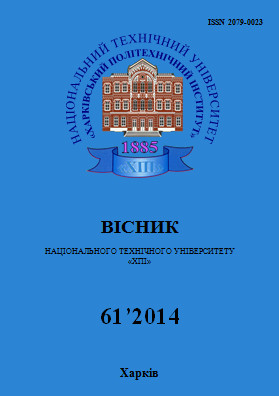Діагностування підприємства як підхід для визначення класу фінансового стану, в якому воно перебуває
DOI:
https://doi.org/10.20998/%25xAbstract
Пропонується діагностування стану підприємства як підхід для визначення його фінансового стану, для представлення існуючої інформації у більш наглядному вигляді, на основі аналізу значень планових та фактичних показників та подальшого визначення плану функціонування підприємства. Для визначення стану підприємства пропонується використовувати технології роботи з неточною інформацією за допомогою нейронних мереж.References
Баканов М. И. Теория экономического анализа. – М. : Финансы и статистика, 2004. – 478 с.
Еремин Д. М. Исскуственные нейронные сети в интеллектуальных системах управления. – Томск : Изд-во Томск. гос. ун-та, 2005. – 210 с.
Ковалев В. В. Финансовый анализ. – Томск : Изд-во Томск. гос. ун-та, 2003. – 45 с.
Гонсалес Д. Р. Принципы распознавания образов / В. Г. Буч, Г. А. Рамбо. – Томск : Изд-во Томск. гос. ун-та, 2008. – 25 с.
Merton R. Continuous-time finance. – Cambr. MA. Blackwell, 1990. – 500 с.
Downloads
Published
2014-12-22
How to Cite
Голоскоков, О. Є., & Скрипченко, Р. А. (2014). Діагностування підприємства як підхід для визначення класу фінансового стану, в якому воно перебуває. Bulletin of National Technical University "KhPI". Series: System Analysis, Control and Information Technologies, (61(1103), 97–105. https://doi.org/10.20998/%x
Issue
Section
SYSTEM ANALYSIS AND DECISION-MAKING THEORY
License
Copyright (c) 2015 Вісник Національного технічного університету «ХПІ». Серія: Системний аналiз, управління та iнформацiйнi технологiїAuthors who publish with this journal agree to the following terms:
- Authors retain copyright and grant the journal right of first publication with the work simultaneously licensed under a Creative Commons Attribution License that allows others to share the work with an acknowledgement of the work's authorship and initial publication in this journal.
- Authors are able to enter into separate, additional contractual arrangements for the non-exclusive distribution of the journal's published version of the work (e.g., post it to an institutional repository or publish it in a book), with an acknowledgement of its initial publication in this journal.
- Authors are permitted and encouraged to post their work online (e.g., in institutional repositories or on their website) prior to and during the submission process, as it can lead to productive exchanges, as well as earlier and greater citation of published work (See The Effect of Open Access).


